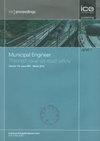城市街道人行横道选择建模(以Qazvin城市街道为例)
IF 0.8
4区 工程技术
Q4 ENGINEERING, CIVIL
Proceedings of the Institution of Civil Engineers-Municipal Engineer
Pub Date : 2022-08-11
DOI:10.1680/jmuen.21.00004
引用次数: 0
摘要
行人是交通事故中最脆弱的道路使用者。本研究旨在分析行人选择路口类型的影响因素。通过PBS问卷和Qazvin市过街行人视频图像的访谈收集所需数据。考虑了个体特征、交叉口选择、交通量以及行人行为潜变量的作用等观察变量对交叉口选择的影响。通过探索性因素分析,发现潜在的行为变量,并将其分为积极习惯和消极习惯。此外,本文还采用了结构方程模型、传统的二元logit模型和混合离散选择模型。结果显示,男性比女性更不愿意使用人行天桥。此外,18-30岁和30-45岁的年轻人比老年人更渴望使用立交桥。此外,消极的行为习惯,如分心、注意力不集中、错误和违规,导致选择比平交道口更危险的选择。此外,日常步行等积极的行为习惯对选择更安全的交叉方式(人行天桥)有积极的影响。研究结果有助于制定政策措施,建设安全高效的设施。本文章由计算机程序翻译,如有差异,请以英文原文为准。
Modeling the Pedestrian Crossing Choice in Urban Streets (Case study: Qazvin Urban Streets)
Pedestrians are the most vulnerable road users in traffic accidents. This study aims to analyze the effective factors in choosing the type of crossing by pedestrians. The required data were collected through interviews based on PBS questionnaire and video images of crossing pedestrians in Qazvin city. The observed variables such as individual characteristics, crossing choices, traffic volume and the role of latent variables of pedestrian behaviors are considered on crossing choices. Latent behavioral variables were identified through exploratory factor analysis and were divided into positive and negative habits. In addition, structural equation model, traditional binary logit, and hybrid discrete choice model were used in this paper. The results show that men are less likely to use a pedestrian overpass than women. In addition, young people in the range of 18-30 and 30-45 are more eager to use overpass than older ones. Further, negative behavioral habits such as distraction and inattention, error, and violation resulted in choosing a riskier alternative compared to level crossing. Further, positive behavioral habits such as daily walking had a positive effect on choosing safer crossing alternative (pedestrian overpass). The findings are useful in developing policy measures to build safe and efficient facilities.
求助全文
通过发布文献求助,成功后即可免费获取论文全文。
去求助
来源期刊
CiteScore
3.70
自引率
0.00%
发文量
15
审稿时长
>12 weeks
期刊介绍:
Municipal Engineer publishes international peer reviewed research, best practice, case study and project papers reports. The journal proudly enjoys an international readership and actively encourages international Panel members and authors. The journal covers the effect of civil engineering on local community such as technical issues, political interface and community participation, the sustainability agenda, cultural context, and the key dimensions of procurement, management and finance. This also includes public services, utilities, and transport. Research needs to be transferable and of interest to a wide international audience. Please ensure that municipal aspects are considered in all submissions. We are happy to consider research papers/reviews/briefing articles.

 求助内容:
求助内容: 应助结果提醒方式:
应助结果提醒方式:


